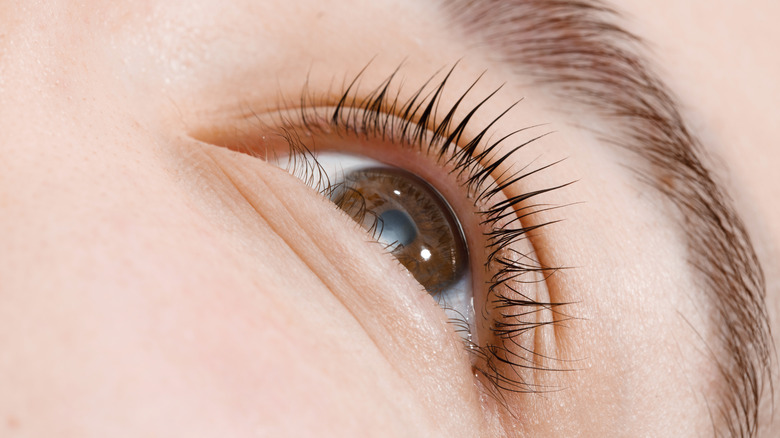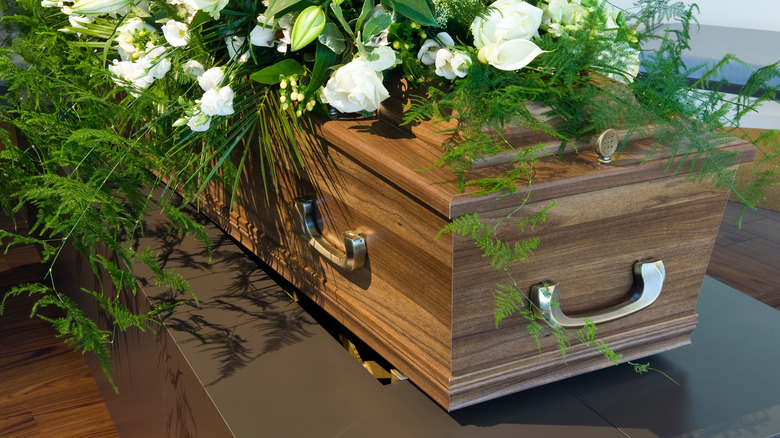What Happens If You Die With Contact Lenses In?
Unlike an average job, morticians deal with the dead rather than the living. As the U.S. News & World Report explains, some morticians work as embalmers, while others act as funeral directors. Nevertheless, Bustle notes that morticians get an inside view of what occurs to a body after an individual has died. This includes preparing a body for a funeral. According to Study.com, embalming prevents it from rapidly decaying. This ensures that the body will stay presentable for family members and loved ones until they say their final goodbyes. It also provides the body with a life-like appearance.
In a now-viral video, Minnesota-based mortician Victor M. Sweeney answered embalming questions from Twitter users (as seen on YouTube). One individual asked if excrement removal is part of the post-mortem process. Sweeney replied (via the Mirror), "There's a myth that everyone poops themselves before they die, it's not always the case, sometimes it is." He added, "For my purposes in the funeral home I'll clean them up if they've started to poo due to abdominal pressure and flush out the bowels with a hose." Someone else asked, "If a person wearing contacts dies, does a mortician take them out?" Sweeney answered that he does.
Setting the Features
In Victor M. Sweeney's words (via the Mirror), "Yes, I have always removed contact lenses, because one of the things that we need to do is 'set the feature,' which means close the mouths and eyes." He continued, "We have a device called eye caps that lets us do this, which are basically spikey contact lenses that grip the eyes and remove the contact lenses." According to Absorbent Specialty Products, these eye caps can also give a corpse a more natural and plump appearance. Furthermore, Everplans notes that they keep the eyes closed by holding the eyelid in place.
Legacy writes that the setting of the features occurs before the embalming process. The Talisman reports that death causes the muscles to relax, which results in an open mouth and eyes. Therefore, setting the features is a must. Per Everplans, embalmers use wires to ensure the jaw stays shut. They begin by inserting a screw into the upper and lower jaw with a tool called a needle injector. They then use wire to attach the screws to keep the mouth closed. Embalmers can also choose to sew the mouth shut instead. In this process, a string is threaded around the gums and nostrils until the jaw is closed. Embalmer Jenn Park-Mustacchio said (via The Guardian) that she places "cotton in the mouth to give the person a more natural expression" to complete this step.
The embalming process
Embalmer Addison Lincoln told the Talisman that setting the features is rewarding but daunting. She said, "It's kind of a relaxing thing to make somebody look like who they were when they were alive." However, Everplans reports that this is only the beginning of preparing the body — arterial and cavity embalming is next. In arterial embalming, the blood in a corpse's veins is replaced with formaldehyde and other chemicals to preserve the body. A similar undertaking occurs with cavity embalming — embalmers use a trocar tool to pierce the organs and drain them of all fluids. The organs then get pumped with formaldehyde, and the process is complete.
However, embalming can differ depending on the circumstances under which an individual died. Moreover, Jenn Park-Mustacchio explained (per The Guardian), "Every case is different and requires a special combination of fluids (which are mixed according to the height, weight and physical conditions of the deceased)." Despite the job being messy, Park-Mustacchio noted that it is rewarding.
Another embalmer, Gina Krotee, acknowledged that embalming isn't for everyone and said she's aware of the apprehension and fear one might have to pursue this career. She stated (per Bustle)," I focus on the body as a memory of their life. They aren't in there anymore and there is nothing to be scared of."


